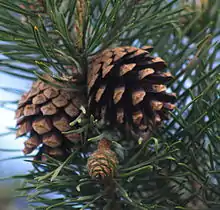Heterospory
Heterospory is the production of spores of two different sizes and sexes by the sporophytes of land plants. The smaller of these, the microspore, is male and the larger megaspore is female. Heterospory evolved during the Devonian period from isospory independently in several plant groups: the clubmosses, the arborescent horsetails,[1] and progymnosperms.[1][2] This occurred as part of the process of evolution of the timing of sex differentiation.[3]


Origin of Heterospory
Heterospory developed due to natural selection pressures that encouraged an increase in propagule size. This may first have led to an increase in spore size and ultimately resulted in the species producing larger megaspores as well as smaller microspores.[4]
Heterospory evolved from homospory many times, but the species in which it first appeared are now extinct. Heterosporic plants that produce seeds are their most successful and widespread descendants.[4] Seed plants constitute the largest subsection of heterosporic plants.[5]
Microspores and Megaspores
Microspores are haploid spores that in endosporic species contain the male gametophyte, which is carried to the megaspores by wind, water currents or animal vectors. Microspores are nearly all nonflagellated, and are therefore not capable of active movement.[6] The morphology of the microspore consists of an outer double walled structures surrounding the dense cytoplasm and central nucleus.[7]
Megaspores contain the female gametophytes in heterosporic plant species. They develop archegonia that produce egg cells that are fertilized by sperm of the male gametophyte originating from the microspore. This results in the formation of a fertilized diploid zygote, that develops into the sporophyte embryo. While heterosporous plants produce fewer megaspores, they are significantly larger than their male counterparts.[7]
In exosporic species, the smaller spores germinate into free-living male gametophytes and the larger spores germinate into free-living female gametophytes. In endosporic species, the gametophytes of both sexes are very highly reduced and contained within the spore wall. The microspores of both exosporic and endosporic species are free-sporing, distributed by wind, water or animal vectors, but in endosporic species the megaspores and the megagametophyte contained within are retained and nurtured by the sporophyte phase. Endosporic species are thus usually dioecious, a condition that promotes outcrossing. Some exosporic species produce micro- and megaspores in the same sporangium, a condition known as homoangy, while in others the micro- and megaspores are produced in separate sporangia (heterangy). These may both be borne on the same monoecious sporophyte or on different sporophytes in dioicous species.[5]
Reproduction
Heterospory was a key event in the evolution of both fossil and surviving plants. The retention of megaspores and the dispersal of microspores allow for both dispersal and establishment reproductive strategies. This adaptive ability of heterospory increases reproductive success as any type of environment favors having these two strategies. Heterospory stops self-fertilization from occurring in a gametophyte, but does not stop two gametophytes that originated from the same sporophyte from mating.[5] This specific type of self-fertilization is termed as sporophytic selfing, and it occurs most commonly among angiosperms. While heterospory stops extreme inbreeding from occurring, it does not prevent inbreeding altogether as sporophytic selfing can still occur.[5]
A complete model for the origin of heterospory, known as the Haig-Westoby model,[8] establishes a connection between minimum spore size and successful reproduction of bisexual gametophytes. For the female function, as minimum spore size increases so does the chance for successful reproduction. For the male function, reproductive success does not change as the minimum spore size increases.
References
- Stewart, W.N.; Rothwell, G.W. (1993). Paleobotany and the evolution of plants (2nd ed.). Cambridge: Cambridge University Press. ISBN 978-0-521-38294-6.
- Bateman, R.M.; Dimichele, W.A. (1994). "Heterospory - the most iterative key innovation in the evolutionary history of the plant kingdom" (PDF). Biological Reviews of the Cambridge Philosophical Society. 69 (3): 345–417. doi:10.1111/j.1469-185x.1994.tb01276.x. S2CID 29709953. Retrieved 2010-12-30.
- Sussex, I.M. (1966) The origin and development of heterospory in vascular plants. Chapter 9 in Trends in Plant morphogenesis, ed. by E.G. Cutter, Longmans.
- Haig, David; Westoby, Mark (1989-11-01). "Selective forces in the emergence of the seed habit". Biological Journal of the Linnean Society. 38 (3): 215–238. doi:10.1111/j.1095-8312.1989.tb01576.x. ISSN 1095-8312.
- Petersen, Kurt B.; Burd, Martin (2016-10-01). "Why did heterospory evolve?". Biological Reviews. 92 (3): 1739–1754. doi:10.1111/brv.12304. ISSN 1469-185X. PMID 27730728.
- Raven, Peter H.; Evert, Ray F.; Eichhorn, Susan E. Biology of Plants. W. H. Freeman.
- Ray, Ankita. "Structure of Microspores and the Development of Male Gametophyte (= germination of Microspores)". Retrieved 13 April 2017.
- Haig, David; Westoby, Mark (1988). "A model for the origin of heterospory". Journal of Theoretical Biology. 134 (2): 257–272. doi:10.1016/s0022-5193(88)80203-0.